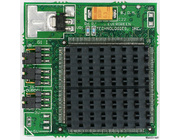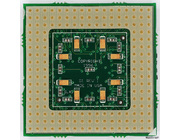Evergreen Am5x86 -P75
The Evergreen 586 is based on the AMD Am5x86 -P75 which is basically a 133MHz 486. Because Evergreen fitted it's CPU with additional logic to control overdrive-mode, cache and multipliers it's adjustable to a number of scenario's you can find in older 486 sytems.
Usually you have to configure your motherboard to run 486DX CPU's (because the Evergreen has an FPU built-in). If you use the overdrive socket, which is often found on older motherboards that have an on-board soldered CPU, you have to switch the jumper over to 'OVRDRV' mode rather than 'NORMAL'. Depending on the final clock-frequency you can switch between 3x or 4x multiplier. Depending on your FSB you can calculate what your final CPU clock-frequency will be (4x25: 100MHz, 3x40: 120MHz, 4x33: 133). Usually it'll be 4x33 which gives 133MHz (original speed of the Am5x86-P75). At last but not least there is a WT/WB switch that controls Write-Through or Write-Back cache. Write-Back is faster but more complex. If the CPU proves to be troublesome then configure WT.
AMD named it's CPU 5x86-P75 because it's performance is, to a certain point, similar to a Pentium 75. Because the 5x86 is really a 486 (it has nothing to do with a 586, it's just marketing) it's floating point unit (FPU) is much weaker than that of a Pentium. It's ALU performance is quite on par with a Pentium 75 but games like Quake really show that the FPU of a 486 is much weaker.
Also keep in mind that it's still based on the 486 platform so the busspeed is still 33MHz. The Pentium 75 exceeds this with it's 50MHz bus. Despite that the PCI-bus of the Pentium 75 runs at just 25MHz (and 33MHz on the 486-platform) you'll see that games like Doom still run better on the Pentium 75.
I have benchmarked a stock Am5x85-P75: the results can be found here. The red-bar is the Am5x86-P75 and the grey bar is a Pentium 75.
 B3D S32
B3D S32


